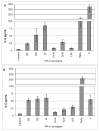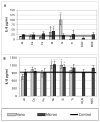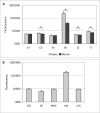Cytokine responses of human lung cells (BEAS-2B) treated with micron-sized and nanoparticles of metal oxides compared to soil dusts
- PMID: 17326846
- PMCID: PMC1821039
- DOI: 10.1186/1743-8977-4-2
Cytokine responses of human lung cells (BEAS-2B) treated with micron-sized and nanoparticles of metal oxides compared to soil dusts
Abstract
Background: The induction of cytokines by airway cells in vitro has been widely used to assess the effects of ambient and occupational particles. This study measured cytotoxicity and the release of the proinflammatory cytokines IL-6 and IL-8 by human bronchial epithelial cells treated with manufactured nano- and micron-sized particles of Al2O3, CeO2, Fe2O3, NiO, SiO2, and TiO2, with soil-derived particles from fugitive dust sources, and with the positive controls LPS, TNF-alpha, and VOSO4.
Results: The nano-sized particles were not consistently more potent than an equal mass of micron-sized particles of the same nominal composition for the induction of IL-6 and IL-8 secretion in the in vitro models used in this study. The manufactured pure oxides were much less potent than natural PM2.5 particles derived from soil dust, and the cells were highly responsive to the positive controls. The nano-sized particles in the media caused artifacts in the measurement of IL-6 by ELISA due to adsorption of the cytokine on the high-surface-area particles. The potency for inducing IL-6 secretion by BEAS-2B cells did not correlate with the generation of reactive oxygen species in cell-free media.
Conclusion: Direct comparisons of manufactured metal oxide nanoparticles and previously studied types of particles and surrogate proinflammatory agonists showed that the metal oxide particles have low potency to induce IL-6 secretion in BEAS-2B cells. Particle artifacts from non-biological effects need to be considered in experiments of this type, and the limitations inherent in cell culture studies must be considered when interpreting in vitro results. This study suggests that manufactured metal oxide nanoparticles are not highly toxic to lung cells compared to environmental particles.
Figures









Similar articles
-
Assessing toxicity of fine and nanoparticles: comparing in vitro measurements to in vivo pulmonary toxicity profiles.Toxicol Sci. 2007 May;97(1):163-80. doi: 10.1093/toxsci/kfm018. Epub 2007 Feb 14. Toxicol Sci. 2007. PMID: 17301066
-
Diesel exhaust particles induced release of interleukin 6 and 8 by (primed) human bronchial epithelial cells (BEAS 2B) in vitro.Exp Lung Res. 1998 Jan-Feb;24(1):85-100. doi: 10.3109/01902149809046056. Exp Lung Res. 1998. PMID: 9457471
-
Correlation of in vitro cytokine responses with the chemical composition of soil-derived particulate matter.Environ Health Perspect. 2006 Mar;114(3):341-9. doi: 10.1289/ehp.8360. Environ Health Perspect. 2006. PMID: 16507455 Free PMC article.
-
Particle characteristics responsible for effects on human lung epithelial cells.Res Rep Health Eff Inst. 2002 Dec;(110):1-65; discussion 67-76. Res Rep Health Eff Inst. 2002. PMID: 12578113 Review.
-
Regulation of cytokine production in human alveolar macrophages and airway epithelial cells in response to ambient air pollution particles: further mechanistic studies.Toxicol Appl Pharmacol. 2005 Sep 1;207(2 Suppl):269-75. doi: 10.1016/j.taap.2005.01.023. Toxicol Appl Pharmacol. 2005. PMID: 15993911 Review.
Cited by
-
Screening for Oxidative Stress Elicited by Engineered Nanomaterials: Evaluation of Acellular DCFH Assay.Dose Response. 2012;10(3):308-30. doi: 10.2203/dose-response.10-036.Pal. Epub 2011 May 26. Dose Response. 2012. PMID: 22942866 Free PMC article.
-
Toxicology of Nanoparticles in Drug Delivery.Curr Pathobiol Rep. 2021;9(4):133-144. doi: 10.1007/s40139-021-00227-z. Epub 2021 Nov 24. Curr Pathobiol Rep. 2021. PMID: 34840918 Free PMC article. Review.
-
Exposure of CuO Nanoparticles Contributes to Cellular Apoptosis, Redox Stress, and Alzheimer's Aβ Amyloidosis.Int J Environ Res Public Health. 2020 Feb 5;17(3):1005. doi: 10.3390/ijerph17031005. Int J Environ Res Public Health. 2020. PMID: 32033400 Free PMC article.
-
Tracking stem cells with superparamagnetic iron oxide nanoparticles: perspectives and considerations.Int J Nanomedicine. 2017 Jan 25;12:779-793. doi: 10.2147/IJN.S126530. eCollection 2017. Int J Nanomedicine. 2017. PMID: 28182122 Free PMC article. Review.
-
C5a/C5aR1 axis as a key driver promotes epithelial-to-mesenchymal transition in airway epithelial cells in silica nanoparticles-induced pulmonary fibrosis.Int Immunopharmacol. 2023 Dec;125(Pt B):111112. doi: 10.1016/j.intimp.2023.111112. Epub 2023 Nov 8. Int Immunopharmacol. 2023. PMID: 37948857 Free PMC article.
References
-
- HEI . Understanding the Health Effects of Components of the Particulate Matter Mix: Progress and Next Steps. Cambridge, MA , Health Effects Institute; 2002.
-
- Kelley J. Lung Biology in Health and Disease. Vol. 61. New York , Marcel Dekker; 1993. Cytokines of the lung.
-
- Nelson S, Martin TR. Lung Biology in health and disease. Vol. 141. New York , Marcel Dekker; 2000. Cytokines in pulmonary disease: infection and inflammation.
-
- Thèze J. The Cytokine Network and Immune Functions. New York , Oxford University Press; 1999.
-
- Mills PR, Davies RJ, Devalia JL. Airway epithelial cells, cytokines, and pollutants. Am J Respir Crit Care Med. 1999;160:S38–S43. - PubMed
Grants and funding
LinkOut - more resources
Full Text Sources

